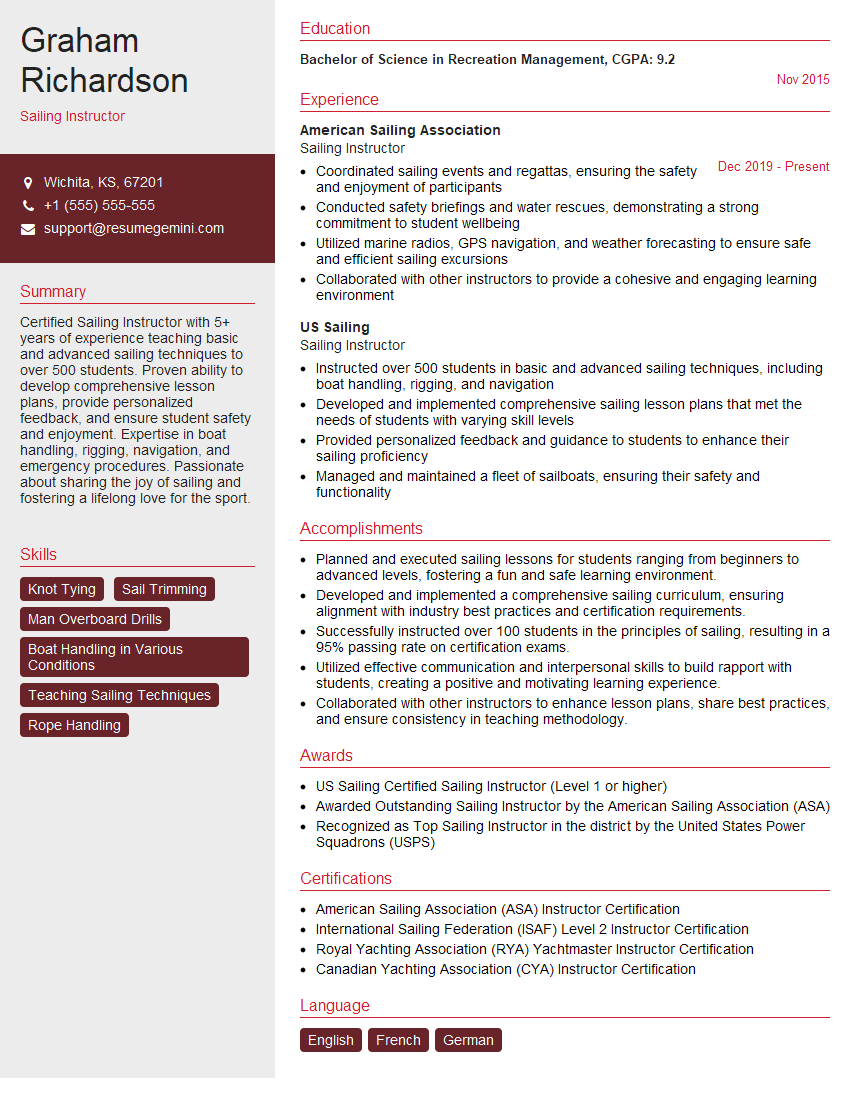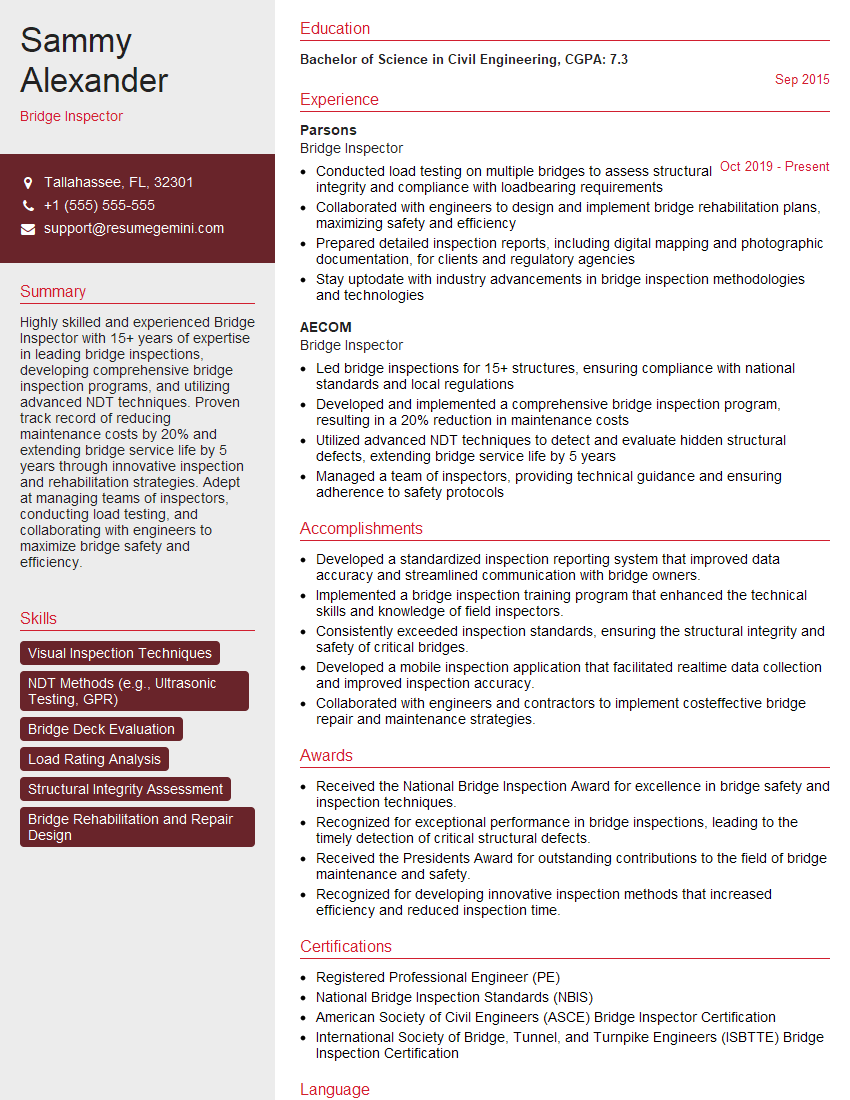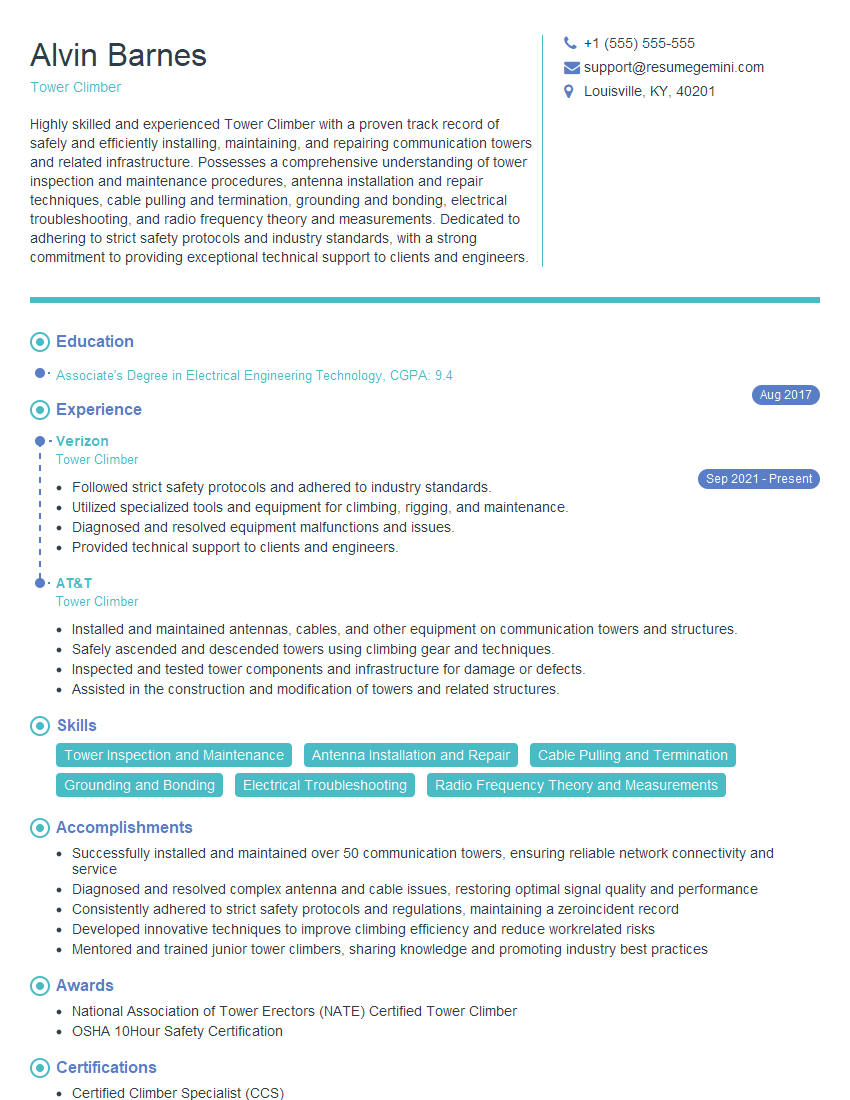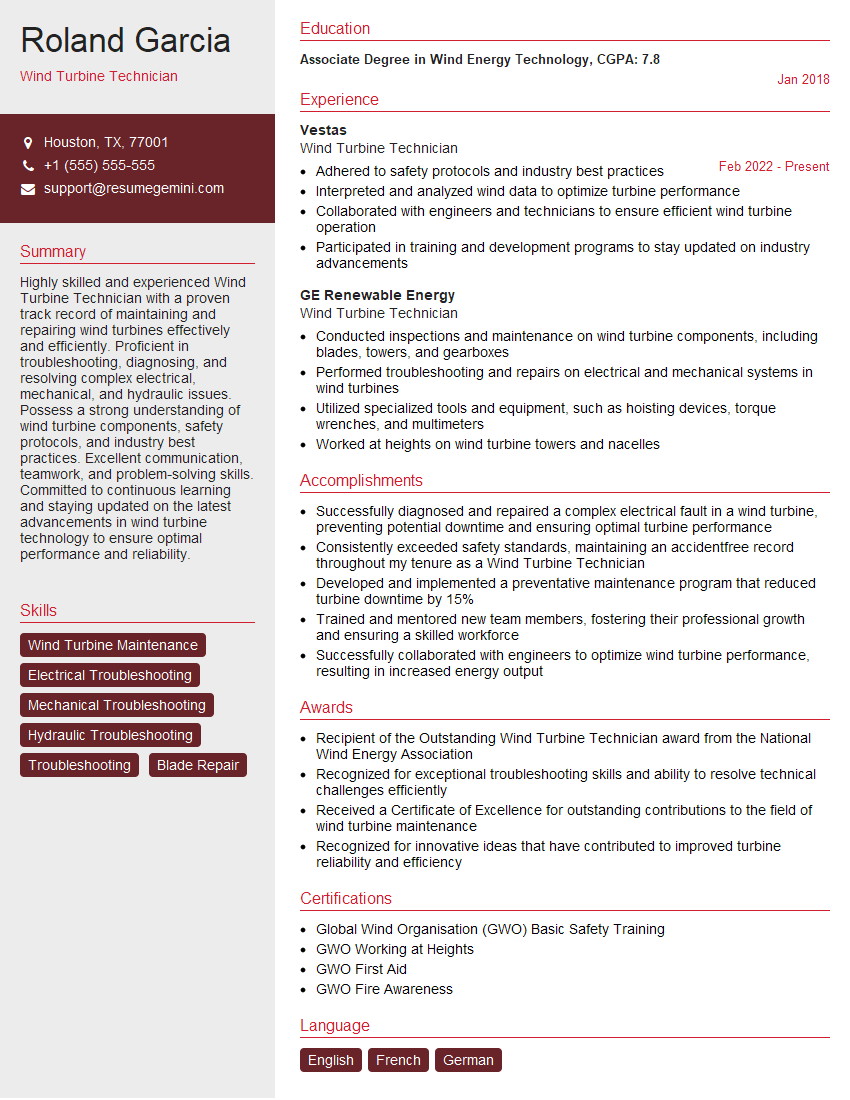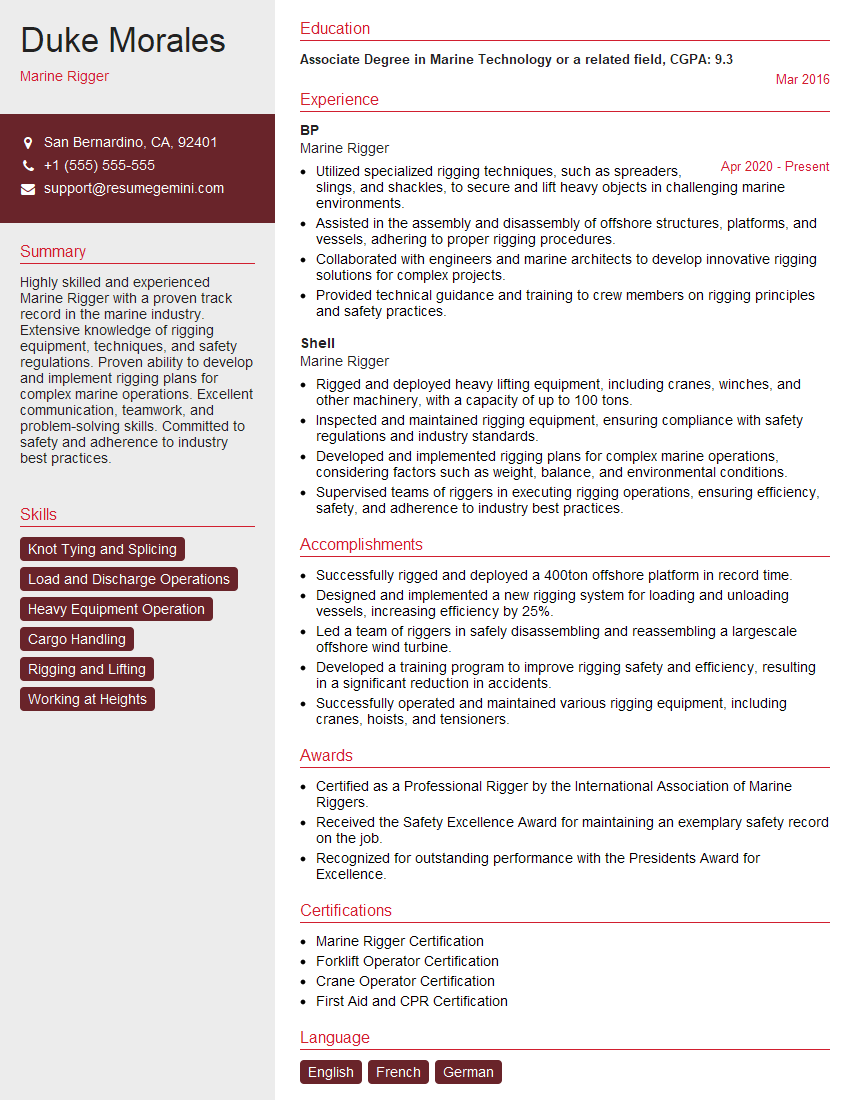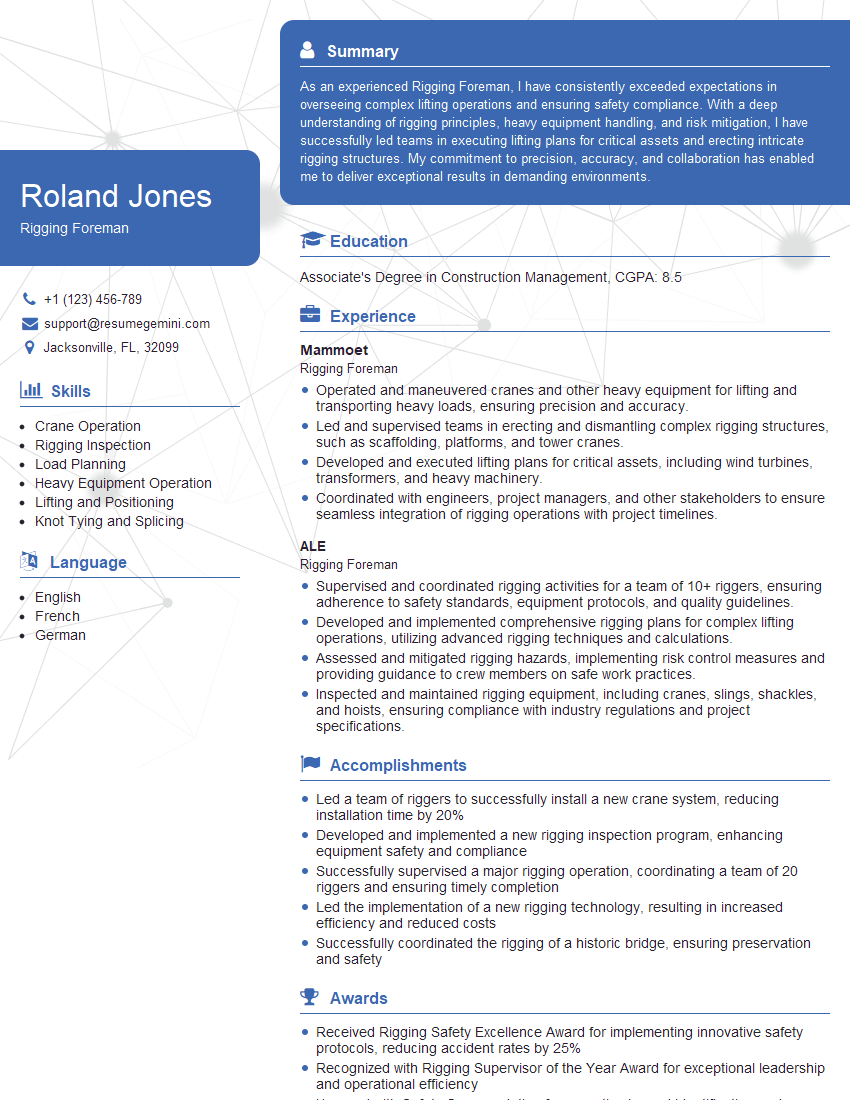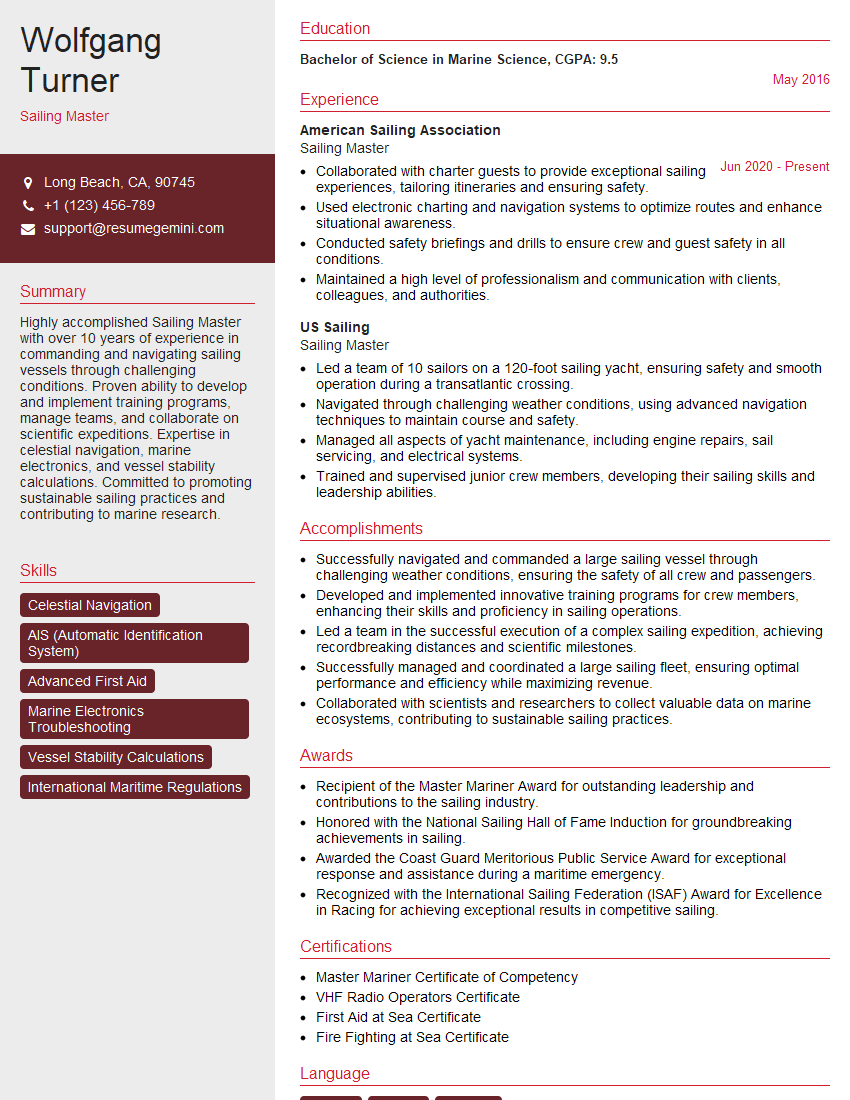Are you ready to stand out in your next interview? Understanding and preparing for Halyard and Rope Handling interview questions is a game-changer. In this blog, we’ve compiled key questions and expert advice to help you showcase your skills with confidence and precision. Let’s get started on your journey to acing the interview.
Questions Asked in Halyard and Rope Handling Interview
Q 1. Explain the different types of halyards and their applications.
Halyards are lines used to hoist or control the position of sails, flags, or other equipment on boats, cranes, or other structures. Different applications demand different types of halyards. Here are some common types:
- Manila Halyards: Traditionally made from manila hemp, these are relatively inexpensive and strong, but susceptible to rotting and shrinking if not properly maintained. They are often seen on older vessels or in less demanding applications.
- Nylon Halyards: Extremely strong and lightweight, nylon halyards are popular for their excellent stretch properties, which act as a shock absorber. However, this stretch can be a drawback when precise sail control is needed.
- Polyester Halyards: Offering a good balance between strength, stretch, and cost, polyester halyards are a popular choice. They possess less stretch than nylon, making them suitable for situations requiring more precise control.
- Dyneema/Spectra Halyards: These high-performance halyards are made from ultra-high-molecular-weight polyethylene (UHMWPE) fibers. They are incredibly strong and lightweight, with minimal stretch, but they are more expensive and susceptible to abrasion. These are commonly found on high-performance sailing vessels.
- Wire Halyards: Used for heavy-duty lifting, wire halyards provide exceptional strength and durability, but are heavier and more difficult to handle than fiber halyards. They are used for applications like lifting heavy loads on cranes.
The choice of halyard depends on the load it needs to bear, the required level of control, and the environmental conditions. For instance, a small sailboat might use nylon halyards for ease of use and their shock-absorbing properties, whereas a large racing yacht might utilize Dyneema for its strength and minimal stretch.
Q 2. Describe the proper techniques for inspecting a halyard for wear and tear.
Regular inspection of halyards is crucial for safety. This should be done before each use and more frequently in harsh conditions. Here’s a step-by-step guide:
- Visual Inspection: Carefully examine the entire length of the halyard, looking for any signs of wear, such as fraying, cuts, abrasion, or broken fibers. Pay close attention to areas subject to chafing, like where the halyard passes through blocks or around cleats.
- Feel Test: Run your hands along the halyard to detect any unusual stiffness, lumps, or weak spots. A weakened or damaged section might feel thinner or softer than the rest of the rope.
- Check for UV Degradation: Look for signs of fading or discoloration, especially on halyards exposed to prolonged sunlight. UV degradation weakens fibers and reduces the halyard’s strength.
- Inspect the Ends: Examine the ends of the halyard for signs of wear, damage, or improper termination. Ensure that any splices or knots are secure and undamaged.
- Check for Kinks and Bends: Sharp kinks and bends significantly weaken the halyard. These should be straightened out or the rope replaced if straightening is impossible.
If any damage or wear is found, the halyard should be replaced immediately. It’s always better to be safe than sorry when it comes to safety equipment like halyards.
Q 3. What safety measures should be taken when working with halyards at height?
Working with halyards at height presents significant risks. Prioritizing safety is paramount. Here are some crucial safety measures:
- Use appropriate Personal Protective Equipment (PPE): This includes a safety harness, a full-body harness, and a helmet. Appropriate fall protection should always be used.
- Employ a competent spotter or rigger: A second person can assist with handling the halyard, provide support, and ensure your safety.
- Utilize appropriate lifting techniques: Avoid jerky movements and sudden loads. Maintain controlled movements to avoid accidents.
- Inspect the equipment before use: Check all equipment, including halyards, blocks, and shackles, for any signs of damage or wear before commencing work.
- Use appropriate communication: Establish clear communication with your spotter or team members to coordinate movements and actions.
- Follow established safety protocols: Always adhere to the company’s and/or the regulatory body’s safety procedures and guidelines.
- Work within your limitations: If the job is beyond your experience or expertise, consult with a qualified professional.
Remember, neglecting safety can lead to serious injuries or fatalities. Always prioritize safety over speed or efficiency.
Q 4. How do you determine the appropriate working load limit (WLL) for a halyard?
The Working Load Limit (WLL) of a halyard is the maximum safe load that can be applied to it without exceeding its strength. This is not just the breaking strength, but a significantly lower value to ensure safety.
The WLL is determined by the manufacturer based on the material, construction, and diameter of the halyard. This information can typically be found on the halyard itself, its packaging, or in accompanying documentation. If this information is not readily available, the halyard should not be used until the WLL can be verified.
Never exceed the WLL. Doing so greatly increases the risk of the halyard failing, potentially leading to injury or damage. It’s essential to consider safety factors when determining the appropriate halyard for a job and always to use a halyard with a WLL significantly higher than the anticipated load.
Q 5. Explain the different types of rope used in rigging and their properties.
Various ropes are used in rigging, each with unique properties. Here are some common types:
- Nylon: High strength-to-weight ratio, good elasticity (stretch), relatively inexpensive. Susceptible to UV degradation.
- Polyester: Stronger than nylon, less stretch, more resistant to UV degradation. A good all-around choice.
- Dyneema/Spectra: Ultra-high-molecular-weight polyethylene (UHMWPE) fibers. Extremely high strength-to-weight ratio, very little stretch, expensive, susceptible to abrasion.
- Manila: Natural fiber rope, relatively inexpensive, strong but susceptible to rotting and degradation from moisture. Less commonly used in modern rigging.
- Wire Rope: Used for very high loads, excellent strength, durable, but heavy and requires specialized handling techniques.
The choice of rope depends heavily on the application. For example, a climbing rope needs high strength and elasticity, while a mooring line needs high strength and abrasion resistance. Understanding the properties of each type is crucial for selecting the right rope for the job.
Q 6. Describe the proper techniques for splicing rope.
Splicing rope creates a permanent, strong joint without the use of knots. There are various types of splices, but the techniques generally involve carefully unlaying the rope strands and interweaving them with the strands of the other rope end. This process requires practice and skill. There are many detailed guides and tutorials available online and in nautical handbooks illustrating the step-by-step procedures for different splice types, such as a long splice (used to join two ropes of similar diameter), a short splice (useful for shortening a rope), and an eye splice (to form a loop at the end of a rope).
Incorrectly performed splices are weak points and can fail under load. It is strongly recommended to seek out professional instruction or video tutorials from reputable sources before attempting a splice, particularly for critical applications.
Q 7. How do you secure a rope to prevent slippage?
Preventing rope slippage is essential for safety and efficiency. Several methods can be employed:
- Proper Knotting: Use appropriate knots designed for securing ropes, such as a bowline, clove hitch, or figure eight. Ensure the knots are tied correctly and snugly.
- Use of Cleats and Stoppers: Cleats are devices designed for securely holding ropes. Stoppers are additional devices to prevent slippage or accidental release.
- Wrapping and Binding: For temporary securing, wrapping the rope around a solid object and securing it with additional bindings is a simple solution.
- Use of Shackles and Clamps: In more heavy-duty situations, shackles or clamps can provide a secure and reliable connection between the rope and a load or another component.
- Consider Rope Material: Some rope materials inherently have a higher tendency to slip than others. Choosing a rope material with better grip can help minimize slippage.
The best method depends on the application. In all cases, it’s crucial to use appropriate techniques and ensure the chosen method is strong enough to withstand the expected load.
Q 8. What are the different types of knots used in rope handling, and when would you use each?
Knots are fundamental to rope handling, providing secure connections and facilitating various tasks. The choice of knot depends entirely on the specific application and the type of rope being used. Here are a few examples:
Bowline: Forms a strong, reliable loop that won’t slip. Perfect for creating a running loop for attaching a load or securing a person to a lifeline. Think of it as a secure, adjustable loop.
Clove Hitch: A quick and easy knot used for temporarily securing a rope to a post or ring. It’s not as strong as a bowline but is incredibly convenient for temporary attachments.
Figure Eight Knot: Primarily used to create a stopper knot at the end of a rope to prevent it from running through a system. Essential for safety and preventing accidental slippage.
Sheet Bend: Used to join two ropes of different diameters. Imagine needing to connect a thicker main halyard to a thinner control line – this is your go-to knot.
Reef Knot (Square Knot): Simple knot for joining two ropes of similar diameter. While easy to tie, it is not as strong or reliable as the sheet bend and should be used with caution.
The selection process involves considering the load’s weight, the type of material the rope is secured to, the need for a fixed or adjustable loop, and the overall safety requirements. Improper knot selection can lead to serious accidents; always choose the right knot for the job.
Q 9. Explain the importance of using proper safety equipment when handling ropes.
Proper safety equipment is paramount in rope handling. Ignoring safety can lead to severe injuries or fatalities. Essential equipment includes:
Gloves: Protect hands from abrasion and rope burns.
Hard hats: Prevent head injuries from falling objects or swinging ropes.
Safety harnesses and lanyards: Provide fall protection when working at height.
Eye protection: Protects eyes from flying debris.
Appropriate footwear: Provides good grip and ankle support.
Beyond this, a thorough risk assessment is crucial before any rope work commences. Understanding the potential hazards and using the right equipment will mitigate the risks and ensure a safer working environment. Never compromise on safety – it’s simply not worth the risk.
Q 10. How do you assess the condition of a rope before use?
Assessing rope condition before use is crucial to prevent accidents. A thorough inspection should cover the following:
Visual Inspection: Look for signs of wear and tear, such as fraying, cuts, abrasion, or discoloration. Pay close attention to the ends of the rope, as these are often the most vulnerable areas.
Feel Test: Run your hands along the rope to detect any stiffness, unusual softness, or broken fibers. A rope that feels brittle or weak should be immediately discarded.
Check for Kinks and Knots: Kinks weaken the rope significantly. Any knots that were previously tied should be carefully examined for damage.
Check the Rope’s Documentation: If the rope has a manufacturer’s tag or documentation, check for its age and recommended usage. Ropes often have a lifespan and should be regularly replaced.
If any issues are detected, the rope should be taken out of service and replaced. Using a damaged rope is incredibly dangerous and should never be tolerated.
Q 11. Describe the process of rigging a load for lifting.
Rigging a load for lifting is a complex process demanding careful planning and execution. The steps are:
Assess the Load: Determine the weight, dimensions, and center of gravity of the load. This information will determine the appropriate type and size of rigging hardware needed.
Select Rigging Hardware: This includes selecting the appropriate slings, shackles, hooks, and other hardware to safely lift and support the load. The hardware must be rated for the weight of the load and have a safety factor built in.
Attach the Slings: The slings are correctly attached to the load, ensuring even distribution of the weight. This often involves using multiple slings to create a balanced lift.
Connect to the Lifting Mechanism: The slings are connected to the crane hook or other lifting device. This must be done securely and carefully, to avoid any slippage or unintended movement of the load.
Test Lift: Before fully lifting the load, perform a test lift to ensure everything is properly secured and the load is stable. This is a critical step to check for any issues that may lead to a catastrophic failure.
Lift and Positioning: Carefully lift and maneuver the load to its designated position. Ensure a clear path and that the load is positioned properly before fully lowering the load.
Rigging is a specialized skill and requires formal training. Improper rigging can lead to serious accidents. If you’re not properly trained, always seek assistance from a qualified rigger.
Q 12. What are the common hazards associated with rope handling?
Rope handling presents numerous hazards, including:
Strangulation: Ropes can cause strangulation if they wrap around a person’s neck or body.
Crushing injuries: Heavy loads can crush workers if dropped or if the rigging fails.
Falls from height: Failure of ropes used for fall protection can result in serious or fatal falls.
Burns: Friction from rapidly moving ropes can cause burns.
Eye injuries: Flying debris or snapped ropes can cause eye injuries.
Cuts and lacerations: Sharp edges or broken fibers can cause cuts and lacerations.
These hazards can be significantly reduced or eliminated by adhering to strict safety procedures, using appropriate safety equipment, and receiving proper training. Always remember that safety is non-negotiable.
Q 13. How do you respond to a rope failure?
A rope failure is a serious event that requires immediate and decisive action. The response will depend on the circumstances, but generally includes:
Secure the area: Evacuate personnel from the immediate vicinity to prevent further injury.
Assess the damage: Determine the cause of the failure and the extent of any damage to equipment or personnel.
Provide first aid: If anyone is injured, provide immediate first aid and call for medical assistance.
Investigate the cause: A thorough investigation must be performed to identify the root cause of the failure to prevent future incidents. This often involves examining the failed rope, reviewing work practices, and inspecting related equipment.
Report the incident: Report the incident to the appropriate authorities and follow company safety procedures.
Prevention is always better than cure. Regular rope inspections, proper maintenance, and thorough training are essential for minimizing the risk of rope failure.
Q 14. What are the different types of rope terminations?
Rope terminations are essential for creating secure and reliable ends. Different methods are used depending on the application and the type of rope:
Whipping: A simple technique for preventing fraying at the rope end. It involves tightly wrapping a small piece of twine or cord around the end of the rope.
Splicing: A more complex technique of interweaving the rope strands to create a seamless and strong termination. This results in a very strong, durable, and smooth end. Often used for halyards and running rigging.
Eye Splice: A splice that creates a loop at the end of the rope. Commonly used to create a secure attachment point.
Loop Splice: A more complex splice that forms a loop with a better load distribution compared to a simple knot.
Use of Hardware: Many times, rope ends are terminated by using specialized hardware such as thimbles (protect the splice), shackles, and various metal clamps designed for specific applications.
The choice of termination method depends on factors like the rope type, its strength requirements, and the type of attachment needed. Proper termination is crucial to the rope’s strength and reliability.
Q 15. Explain the importance of regular rope maintenance.
Regular rope maintenance is crucial for ensuring safety and extending the lifespan of your ropes and halyards. Think of it like regular car maintenance – neglecting it leads to potential breakdowns and accidents. Ignoring even minor wear and tear can drastically reduce a rope’s strength and ultimately lead to catastrophic failure.
- Visual Inspection: Regularly check for fraying, cuts, abrasions, and signs of chemical damage. Look for any unusual stiffness or softness.
- Cleaning: Remove dirt and debris, which can weaken the fibers and cause damage. The cleaning method will depend on the rope material; some require specialized cleaning agents.
- Storage: Store ropes in a cool, dry place, away from direct sunlight and harsh chemicals. Keep them coiled loosely to avoid kinks and stresses.
- Testing: Periodically conduct strength tests, particularly for critical applications, using calibrated equipment to ensure the rope meets required standards.
For example, a frayed climbing rope could snap under load, causing a serious fall. Similarly, a weakened halyard on a sailboat could fail, causing damage to the sails or even injury to the crew.
Career Expert Tips:
- Ace those interviews! Prepare effectively by reviewing the Top 50 Most Common Interview Questions on ResumeGemini.
- Navigate your job search with confidence! Explore a wide range of Career Tips on ResumeGemini. Learn about common challenges and recommendations to overcome them.
- Craft the perfect resume! Master the Art of Resume Writing with ResumeGemini’s guide. Showcase your unique qualifications and achievements effectively.
- Don’t miss out on holiday savings! Build your dream resume with ResumeGemini’s ATS optimized templates.
Q 16. How do you calculate the safe working load of a rope assembly?
Calculating the safe working load (SWL) of a rope assembly isn’t a simple equation; it’s a careful consideration of multiple factors. The manufacturer’s data sheet provides the SWL for a *single* rope under ideal conditions. However, a rope assembly involves multiple components and factors that reduce the overall strength.
- Rope Material and Diameter: The SWL is directly related to the rope’s material and diameter. Thicker ropes generally have higher SWL.
- Number of Strands and Construction: The type of braid, the number of strands, and the overall construction significantly impact strength.
- Degradation Factors: Age, UV exposure, abrasion, and chemical damage reduce the rope’s strength; therefore the SWL must be de-rated.
- Attachment Points: The strength of the shackles, hooks, and other attachment points must be equal to or greater than the rope’s SWL. A weak link will be the point of failure.
- Angle of Pull: The SWL decreases as the angle of pull deviates from a straight vertical line. A significant angle reduces the effective strength significantly.
Therefore, calculating the safe working load requires a safety factor. This factor accounts for the uncertainties involved and can range from 5:1 to 10:1, depending on the application and risk level. Always err on the side of caution. Consult relevant safety standards and engineering guides to determine an appropriate safety factor for your application.
Q 17. Describe the different types of lifting equipment used in conjunction with ropes and halyards.
Various types of lifting equipment are used in conjunction with ropes and halyards, each suited to specific tasks and load capacities. Selecting the right equipment is critical for safety and efficiency.
- Blocks and Pulleys: These redirect force, increase mechanical advantage (allowing you to lift heavier loads with less effort), and change the direction of the pull.
- Shackles and Hooks: Used to connect ropes to other components in the system, like lifting beams or cargo.
- Winches and Hoists: Mechanized devices that provide controlled lifting and lowering capabilities. Electric, manual, or hydraulic winches offer different levels of power and control.
- Lifting Beams and Spreads: Distribute the load evenly across multiple attachment points, improving stability and reducing stress on individual ropes.
- Chain Hoists: Hand-operated or electric chain hoists offer a precise and reliable way to lift and lower loads.
For example, in rigging a heavy object, one might use a winch to initially lift the load, then employ blocks and tackles to change the direction of the lift and maneuver it into place. Shackles would secure the lifting points on the object and the connection to the lifting system.
Q 18. How do you ensure the stability of a load during lifting operations?
Ensuring load stability during lifting operations is paramount to prevent accidents. It involves careful planning and execution, with emphasis on several key aspects.
- Proper Rigging: Using appropriate ropes, blocks, and tackles, ensuring all components are correctly sized and in good condition.
- Balanced Load: Distributing the weight evenly prevents swaying and reduces stress on individual ropes or lifting points.
- Secure Attachments: Making sure the load is properly secured to the lifting equipment, preventing it from shifting or detaching during lifting.
- Controlled Lifting and Lowering: Using slow, controlled movements prevents sudden jerks or swings that can destabilize the load. Avoid rapid changes in direction.
- Spotters and Communication: Having trained personnel to guide the load and communicate with the operator during lifting operations.
- Proper Lifting Techniques: Taking into account wind conditions and other environmental factors.
Imagine lifting a large, irregularly shaped object. If the load isn’t balanced, it could swing unpredictably, potentially causing damage or injury. Therefore, it’s crucial to carefully plan the lift, use appropriate lifting equipment, and employ safe lifting practices.
Q 19. What are the regulatory requirements for working at height using ropes?
Regulatory requirements for working at height using ropes vary by location but generally adhere to international safety standards. These requirements aim to mitigate the risks inherent in working at height, ensuring the safety of workers.
- Competent Personnel: Only trained and qualified individuals should perform rope access work. This usually involves certification in relevant techniques and safety procedures.
- Risk Assessments: A detailed risk assessment must be carried out before any work commences, identifying potential hazards and implementing appropriate control measures.
- Equipment Inspection and Maintenance: Regular inspection and maintenance of all ropes, harnesses, and other equipment are critical. Equipment must be certified and within its safe working limits.
- Fall Protection Systems: Appropriate fall protection measures, such as safety harnesses and lifelines, must be in place.
- Emergency Procedures: Emergency procedures must be established and practiced, including rescue plans in case of falls or equipment failure.
- Compliance with Standards: Adherence to relevant national and international safety standards, such as those set by OSHA or equivalent regulatory bodies.
These regulations are not just guidelines; they’re legally mandated to ensure the safety of workers and prevent accidents. Ignoring these requirements can result in serious penalties and legal repercussions.
Q 20. Explain your experience with different types of rope materials (e.g., nylon, polyester, steel).
My experience encompasses a wide range of rope materials, each possessing unique characteristics that suit different applications. The choice of material is critical for the success and safety of any operation.
- Nylon: Known for its high strength-to-weight ratio, elasticity, and resistance to abrasion. Ideal for general-purpose applications, but can be susceptible to UV degradation over prolonged exposure.
- Polyester: Offers superior strength, lower stretch than nylon, and better resistance to UV degradation. A good choice for applications demanding high strength and dimensional stability.
- Steel Wire Rope: Used where extremely high strength is required, like heavy lifting or industrial applications. Less flexible than synthetic ropes and susceptible to corrosion.
For instance, in climbing, nylon ropes are favored for their elasticity, which helps absorb shock during falls. In sailing, polyester halyards are preferred for their strength and UV resistance. Steel wire ropes are often used in cranes and heavy lifting applications where strength is paramount.
I’ve worked extensively with all three types, understanding their strengths and limitations allows me to make informed decisions regarding material selection, ensuring the safety and effectiveness of rope systems in diverse environments.
Q 21. Describe a situation where you had to troubleshoot a problem related to rope or halyard failure.
During a rigging operation involving a heavy piece of machinery, we experienced a sudden drop in the lifting capacity. A preliminary inspection revealed no obvious damage to the main lifting ropes. However, a thorough examination revealed a hidden fray in the inner core of one of the ropes, not easily visible from the outside. This fraying was likely caused by abrasion against a sharp edge during a previous lift which wasn’t properly identified and addressed.
My troubleshooting involved:
- Immediate Halt to Operations: Safety is paramount; the lift was immediately stopped to prevent any potential accidents.
- Thorough Inspection: A detailed examination of all ropes and rigging components was carried out to identify the cause of the problem.
- Replacement of the Damaged Rope: The frayed rope was immediately replaced with a new one, ensuring it met all relevant safety standards.
- Review of Procedures: We conducted a review of our inspection and safety procedures to determine how the fraying went undetected and to implement preventative measures in future operations.
This incident highlighted the importance of thorough inspections, attention to detail, and the need for continuous improvement in safety procedures. We learned a valuable lesson about the potential for hidden damage and the importance of proactive maintenance.
Q 22. How do you communicate safety procedures to a team working with ropes?
Communicating safety procedures for rope work requires a multi-faceted approach ensuring everyone understands and adheres to them. It begins with a pre-task briefing, where I clearly outline the specific hazards associated with the job, like potential falls, equipment failure, or environmental factors. I explain each step of the process, highlighting critical safety points, like proper knot tying, equipment inspection, and communication protocols.
I use visual aids like diagrams or demonstrations to illustrate proper techniques. For instance, I’ll show the team how to correctly inspect a rope for wear and tear before each use. I emphasize the importance of using the buddy system, where team members constantly check on each other’s safety. Finally, I encourage open communication – team members are expected to voice any concerns or questions immediately. A simple ‘time out’ is always encouraged if anyone feels unsafe or unsure about a procedure. Post-task briefings are equally crucial to discuss what went well, areas for improvement, and any near misses. Regular refresher training keeps safety protocols top of mind.
Q 23. Describe your experience with different types of knots and hitches.
My experience encompasses a wide range of knots and hitches, both practical and specialized. I’m proficient in fundamental knots like the bowline (a reliable loop that won’t slip), the figure eight (for securing a rope to an anchor point), and the clove hitch (useful for quickly attaching a rope to a post or ring). I also have extensive experience with more complex knots such as the prusik knot (used for ascending or descending ropes), the double fisherman’s knot (for joining two ropes of similar diameter), and various types of hitches like the running bowline or the taut-line hitch (for adjusting tension in a line). My experience extends to understanding the strength, limitations, and applications of each knot in various scenarios. For example, I would never use a bowline for a load-bearing application that requires a highly secure, non-slipping knot. In such situations, a more secure knot like a double fisherman’s would be chosen. I regularly practice and test my knot-tying skills to maintain proficiency and adapt my knowledge to the demands of different tasks.
Q 24. What are the limitations of synthetic ropes compared to natural fiber ropes?
Synthetic ropes, while offering advantages like high strength-to-weight ratios and durability, have limitations compared to natural fiber ropes. Synthetic ropes are susceptible to UV degradation, meaning prolonged sun exposure can weaken their fibers. This is unlike natural fibers which have a degree of inherent UV resistance. Synthetic ropes can also be damaged by abrasion, and their strength can be significantly reduced by chemicals or extreme temperatures. Natural fiber ropes, like manila or sisal, are generally more flexible and easier to handle, particularly in cold weather. However, they are less strong than modern synthetics and are highly susceptible to moisture absorption which significantly affects their strength and longevity. The choice between synthetic and natural fiber ropes depends heavily on the specific application and the environmental conditions. For high-strength applications requiring long-term durability, despite UV sensitivity, synthetic ropes are often preferred. In situations with potential chemical exposure, the appropriate type of synthetic rope must be chosen.
Q 25. What is the significance of using a proper tag line during lifting operations?
A tag line is a crucial safety element during lifting operations, acting as a secondary control system to help prevent accidents. It’s a lighter rope attached to the load, providing an additional means of control should the primary lifting mechanism fail or experience unexpected movement. This allows for a controlled lowering of the load, preventing a dangerous drop. A tag line enables the operators to guide and stabilize the load during lifting, especially in windy conditions or where precise placement is essential. It helps to prevent the load from swinging, colliding with obstacles, or becoming tangled. For instance, imagine lifting a heavy piece of equipment: the primary hoist might malfunction. The tag line gives workers the chance to intervene and prevent a potential disaster. The tag line provides critical redundancy in the safety system.
Q 26. How do you handle different weather conditions when working with ropes?
Weather conditions significantly impact rope handling. In high winds, additional precautions are necessary, such as using heavier ropes and anchoring them securely. It’s also critical to assess the wind’s direction and strength to minimize the risk of the load swinging. Rain or snow can reduce friction and make ropes slippery, potentially affecting grip and knot security. We use appropriate techniques to handle wet ropes, possibly using gloves for improved grip, and we may need to adjust our knots or use additional safety lines to compensate for reduced friction. Extreme temperatures can also impact ropes – heat can weaken synthetic ropes, while extreme cold can make them brittle. We always select ropes appropriate for the expected temperature range and take precautions to protect them from excessive exposure to harsh conditions. In extreme weather, operations may need to be postponed until conditions improve to ensure both safety and prevent damage to equipment.
Q 27. Explain the process of selecting appropriate Personal Protective Equipment (PPE) for rope access work.
Selecting appropriate PPE for rope access work is paramount. The specific PPE will depend on the task, environment, and potential hazards. A full-body harness is essential, providing anchor points for fall arrest systems. It needs to be properly fitted and inspected before each use. A helmet is crucial to protect against falling objects. Gloves provide protection against rope abrasion and improve grip. We must choose gloves suited to the specific ropes being used. Appropriate footwear with good traction is also important, as is a robust and reliable fall arrest system. Depending on the work environment, other PPE may be required, such as eye protection, high-visibility clothing, and protective clothing against weather conditions. It’s crucial to follow the manufacturer’s instructions for each piece of PPE, ensuring it’s correctly fitted and maintained to guarantee maximum effectiveness and safety. Regular inspection of all PPE is mandatory.
Q 28. Describe your understanding of the different types of fall protection systems used in rope access.
Various fall protection systems are used in rope access work, each with its strengths and weaknesses. The most common is a self-retracting lifeline (SRL), which automatically retracts the lifeline should a fall occur. This minimizes the impact force. Another common system is a fixed-length rope with an energy absorber, which helps to decelerate the fall over a longer distance, reducing the impact force. We also use systems combining these components for greater security. The choice of fall protection system depends on factors such as the height of the work, the environment, and the specific tasks being undertaken. For example, in confined spaces, an SRL might be preferred due to its compact nature. The choice of system always prioritizes safety, minimizing the distance of a fall and the potential for injury. Regular inspection, maintenance, and training on the safe use of these systems are critical. All systems must be inspected according to manufacturer’s guidelines before each use.
Key Topics to Learn for Halyard and Rope Handling Interview
- Rope Types and Properties: Understanding different rope materials (e.g., nylon, polyester, wire), their strengths, weaknesses, and appropriate applications in various situations.
- Knots and Splices: Mastering essential knots (e.g., bowline, clove hitch, figure eight) and splicing techniques for secure and efficient rigging.
- Rigging Techniques: Safe and effective methods for setting up and using halyards, including proper tensioning, securing, and inspection procedures.
- Load Calculations and Safety Factors: Applying principles of physics to determine safe working loads for ropes and halyards, understanding safety margins and potential hazards.
- Maintenance and Inspection: Regularly inspecting ropes and halyards for wear and tear, identifying potential problems, and implementing preventative maintenance strategies.
- Emergency Procedures: Developing a plan for handling rope failures or other unexpected events, ensuring safety and minimizing damage.
- Communication and Teamwork: Effective communication protocols in a team environment, emphasizing clear instructions and shared understanding during rigging operations.
- Health and Safety Regulations: Familiarity with relevant safety regulations and best practices to prevent accidents and ensure compliance.
Next Steps
Mastering halyard and rope handling is crucial for career advancement in many industries, demonstrating your practical skills and commitment to safety. A well-crafted resume is your first step towards showcasing these skills to potential employers. Building an ATS-friendly resume is essential for maximizing your job prospects. ResumeGemini is a trusted resource that can help you create a professional and impactful resume tailored to highlight your expertise. We provide examples of resumes specifically tailored to Halyard and Rope Handling to help you get started. Take the next step and create a resume that truly reflects your capabilities!
Explore more articles
Users Rating of Our Blogs
Share Your Experience
We value your feedback! Please rate our content and share your thoughts (optional).
